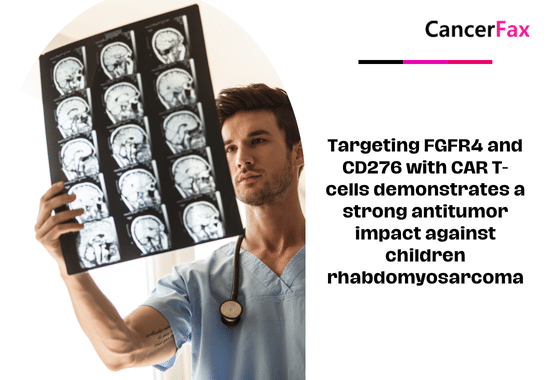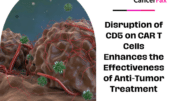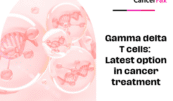Targeting FGFR4 and CD276 with CAR T-cells demonstrates a strong antitumor impact against children rhabdomyosarcoma
CAR T-Cell treatment
Chimeric Antigen Receptor (CAR) T-cell treatments, which target antigens that are unique to cancer, have shown amazing results in curing leukemia and lymphoma that has not responded to other treatments or has come back. Nevertheless, the effectiveness of these treatments in addressing solid tumors has been unsatisfactory due to various obstacles.
Some of these problems are the unstable presence of tumor-associated antigens, the drop in target expression when selection pressure is applied, the weakness of T-cells, the inability for cells to move around enough in the body, an unfavorable tumor microenvironment, the tendency for exhaustion, and the lack of CAR T cells that stay in the body for a long time. Conquering these obstacles in the treatment of solid tumors continues to be a major problem and a subject of ongoing research.
Rhabdomyosarcoma (RMS)
Rhabdomyosarcoma (RMS) is the predominant kind of soft tissue sarcoma found in children, accounting for around 3-4% of all childhood malignancies. In our recent study, we saw that Fibroblast Growth Factor Receptor 4 (FGFR4) levels went up significantly in both PAX3/7-FOXO1 fusion-positive (FP-) and fusion-negative (FN-) RMS. In normal tissues, its expression was very low or not present at all.
Moreover, FGFR4 is a specific gene that is directly regulated by the fusion protein PAX3-FOXO1, resulting in elevated levels of expression in fusion-positive rhabdomyosarcoma (FP-RMS). In addition, around 10% of FN-RMS cases exhibit activating mutations that result in high expression of FGFR4. FGFR4 possesses properties that make it a viable molecular target for treating RMS, including CAR T treatment.
CD276, also known as B7-H3, is a cell surface protein that is part of the significant immunological checkpoint B7 family. Previous studies, including our own, have shown that CD276 is highly expressed in several types of human solid tumors, such as RMS. This overexpression of CD276 has been found to be associated with the advancement of the tumor, its spread to other parts of the body, and a negative prognosis in different types of cancer.
Moreover, PAX3-FOXO1 raises the level of CD276 in FP-RMS20 and is currently being studied as a possible target for CAR T-cell therapy in human cancers. Hence, CD276 serves as a supplementary objective for CAR T treatment in combating RMS.
Second-generation CAR designs offer a high level of customization by allowing the option of a single-chain variable fragment (scFv) binder, hinge transmembrane (HTM), and intracellular co-stimulatory domains (CSD). These components collectively dictate the activation threshold and signaling features of a CAR21. We have recently announced the development of a CAR (chimeric antigen receptor) that specifically targets FGFR4.
This CAR is made with a second-generation CAR design that includes a 4-1BB signaling domain (CSD) and a CD8 hinge and transmembrane domain (HTM). The CAR is currently undergoing testing in a phase I clinical trial. Although the FGFR4 CAR exhibits strong anticancer properties, its therapeutic efficacy remains uncertain in stressful settings, such as when the ratio of infused CAR T-cells to tumor burden is low.
In this study, we first looked at how well our previously described FGFR4 CAR T-cells worked in tough situations. We then tried to make them stronger by replacing the HTM and CSD domains with those of CD28. It was faster to get rid of tumors when the 4-1BB was replaced with a CD28 CSD, but this meant that CAR T-cells lived shorter and got tired more quickly, as previous research had shown.
Single CARs have been more effective, but multi-targeting CARs can stop tumors from escaping because of different antigen expression or loss of target expression due to selection pressure. This phenomenon has been observed in CAR therapies that target single antigens. Nevertheless, the most effective approach for creating dual-targeting CARs has not been definitively determined, particularly for solid tumors. Bivalent constructs exhibit greater potency and are comparatively simpler to employ, in contrast to co-transduction or co-infusion methods.
Other labs’ and our own research has shown that a bicistronic “OR” CAR construct, which has two single targeting CAR cassettes, works better than a bivalent CAR construct with two tandem scFvs. This is partially because the bicistronic construct maintains the structural integrity of the antigen-binding moieties. In addition, it is necessary to evaluate the most effective combination of T-cell CSDs from two distinct CAR cassettes in a bicistronic CAR construct, despite the prevailing belief in the field that dual CD28 and 4-1BB co-stimulation may offer optimal signaling for T-cell activation.
In this study, we enhanced the effectiveness of a FGFR4 CAR by improving its anticancer activity utilizing various HTM and CSDs. Then, we looked at how well bicistronic CARs (BiCisCAR) worked as a treatment for RMS in a number of real-life models. BiCisCAR targets both FGFR4 and CD276. Our research shows that a BiCisCAR, which is made up of two different chimeric antigen receptors (CARs) with their own signaling domains (CSDs), can kill target cells and increase the production of cytokines.
A strong stimulation of the T cell receptor’s (TCR) downstream signaling pathways is necessary to achieve this. The fact that T-cells expressing this BiCisCAR stay active and do not get used up quickly shows that our CAR engineering method targets a lot of different antigens well and provides a strong treatment option for RMS.
Check out the complete details of the study over here.
Susan Hau is a distinguished researcher in the field of cancer cell therapy, with a particular focus on T cell-based approaches and cancer vaccines. Her work spans several innovative treatment modalities, including CAR T-cell therapy, TIL (Tumor-Infiltrating Lymphocyte) therapy, and NK (Natural Killer) cell therapy.
Hau's expertise lies in cancer cell biology, where she has made significant contributions to understanding the complex interactions between immune cells and tumors.
Her research aims to enhance the efficacy of immunotherapies by manipulating the tumor microenvironment and exploring novel ways to activate and direct immune responses against cancer cells.
Throughout her career, Hau has collaborated with leading professors and researchers in the field of cancer treatment, both in the United States and China.
These international experiences have broadened her perspective and contributed to her innovative approach to cancer therapy development.
Hau's work is particularly focused on addressing the challenges of treating advanced and metastatic cancers. She has been involved in clinical trials evaluating the safety and efficacy of various immunotherapy approaches, including the promising Gamma Delta T cell therapy.
- Comments Closed
- July 24th, 2024






CAR-T clinical trials for sarcoma, CAR-T for rhabdomyosarcoma, CD276 (B7-H3) CAR-T therapy, Childhood cancer breakthrough, FGFR4-targeted CAR-T, Pediatric sarcoma immunotherapy, Rare pediatric cancer treatment, Solid tumor CAR-T advances
CancerFax is the most trusted online platform dedicated to connecting individuals facing advanced-stage cancer with groundbreaking cell therapies.
Send your medical reports and get a free analysis.
🌟 Join us in the fight against cancer! 🌟
Привет,
CancerFax — это самая надежная онлайн-платформа, призванная предоставить людям, столкнувшимся с раком на поздних стадиях, доступ к революционным клеточным методам лечения.
Отправьте свои медицинские заключения и получите бесплатный анализ.
🌟 Присоединяйтесь к нам в борьбе с раком! 🌟